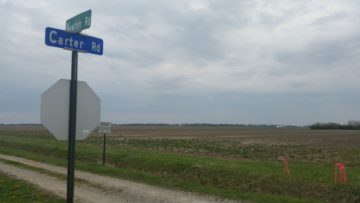By JAN LARSON McLAUGHLIN
BG Independent News
The future is looking pretty bright for Bowling Green’s solar field project, with city council voting unanimously Monday evening to approve plans to install the largest solar field in Ohio.
Concerns were expressed by a neighbor of the site about the loss of prime farmland. But her concerns were not enough to throw shade on the project.
“This looks like a really good addition to the Bowling Green energy portfolio,” said council member Bob McOmber. “I don’t see any minuses with this.”
The solar project had been stalled since last summer. Now, if all goes as planned, an estimated 2,900 homes in the city will be powered by sunlight starting next year.
“I appreciate the project moving forward. Environmentally, it’s a good thing,” council member Bruce Jeffers said. “I’m really happy to see this happen.”
The solar field is expected to produce more power than originally planned.
The initial plan called for 110 acres to be used on the city’s 317 acres located at the southeast corner of Newton and Carter roads, northeast of the city limits. The city was in line to get 10.5 megawatts from the solar field, according to Brian O’Connell, director of utilities for BG.
However, instead of fixed mounted panels, the new plan calls for single axis tracker panels, which will rotate and follow the path of the sun as it moves through the sky.
The rotating panels will take up 35 more acres and cost more to install, but they will increase power production, he said. The solar field will generate 20 megawatts, with Bowling Green getting 13.74 megawatts of the power for its customers.
With the addition of the solar power to the existing wind and hydro sources already used by the city, Bowling Green will get close to 40 percent of its energy from renewable sources starting in 2017, O’Connell said.
“It certainly is a good thing for the city,” council president Mike Aspacher said.

Site of proposed solar field at southeast corner of Carter and Newton roads.
The solar field was initially planned for the western section of the city’s farm acreage. However, to reduce disruption and concerns for neighbors, the solar panels will be constructed in the middle of the acreage, with farmland left on both the east and west ends.
However, neighboring farmer Carol Riker expressed concerns about the loss of quality farmland, the route of the transmission lines, noise, lighting and drainage.
“We’re not against solar,” she explained, but questioned the need to take 145 acres of quality farmland when other acreage may be available. “We’re sad to see good farmland going.”
Jeffers sympathized. “Loss of farmland is a significant issue,” he said.
O’Connell said other sites were considered, but land in the nearby industrial park has already had infrastructure improvements so it is ready for future manufacturers. The city did not consider smaller split up acreage for the project since the large scale of the project helped drive down the costs of the solar field, he said.
Council instructed O’Connell to try to address other concerns with Riker.
Under the solar proposal approved Monday evening, American Municipal Power Inc. will play a different role in the project than initially planned. Originally, AMP planned to own and operate the solar sites in multiple communities. However, AMP was not eligible for federal investment tax credit. So AMP entered into an agreement with NextEra, a third party solar developer.
NextEra, which qualifies for the tax credits, is one of the largest generators of solar energy in the U.S. with more than 700 megawatts of solar generation.
Since the project now qualifies for federal tax credit, it will cost the city less in the long run. With the original solar plan, it was estimated the city would see a 1.1 percent increase in its power supply costs. That increase has been erased with the new proposal.
Construction is planned to start during the third week of June, with the solar field expected to be finished by the end of December.

